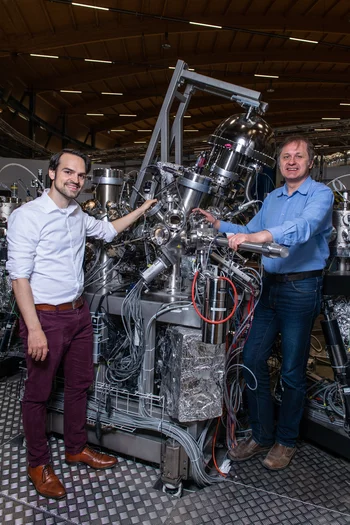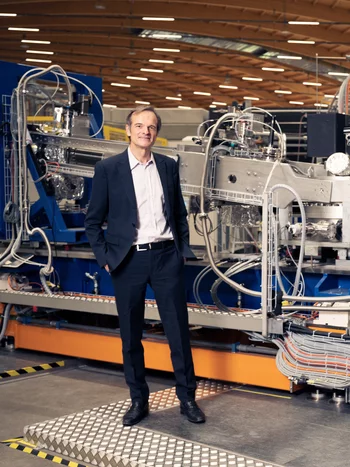Towards compact quantum computers, thanks to topology
Researchers at PSI have compared the electron distribution below the oxide layer of two semiconductors. The investigation is part of an effort to develop particularly stable quantum bits –and thus, in turn, particularly efficient quantum computers. They have now published their latest research, which is supported in part by Microsoft, in the scientific journal Advanced Quantum Technologies.

(Photo: Paul Scherrer Institute/Mahir Dzambegovic)

(Photo: Thomas Baumann)
By now, the future of computing is inconceivable without quantum computers. For the most part, these are still in the research phase. They hold the promise of speeding up certain calculations and simulations by orders of magnitude compared to classical computers.
Quantum bits, or qubits for short, form the basis of quantum computers. So-called topological quantum bits are a novel type that might prove to be superior. To find out how these could be created, an international team of researchers has carried out measurements at the Swiss Light Source SLS at PSI.
More stable quantum bits
“Computer bits that follow the laws of quantum mechanics can be achieved in different ways,” explains Niels Schröter, one of the study’s authors. He was a researcher at PSI until April 2021, when he moved to the Max Planck Institute of Microstructure Physics in Halle, Germany. “Most types of qubits unfortunately lose their information quickly; you could say they are forgetful qubits.” There is a technical solution to this: Each qubit is backed up with a system of additional qubits that correct any errors that occur. But this means that the total number of qubits needed for an operational quantum computer quickly rises into the millions.
“Microsoft’s approach, which we are now collaborating on, is quite different,” Schröter continues. “We want to help create a new kind of qubit that is immune to leakage of information. This would allow us to use just a few qubits to achieve a slim, functioning quantum computer.”
The researchers hope to obtain such immunity with so-called topological quantum bits. These would be something completely new that no research group has yet been able to create.
Topological materials became more widely known through the Nobel Prize in Physics in 2016. Topology is originally a field of mathematics that explores, among other things, how geometric objects behave when they are deformed. However, the mathematical language developed for this can also be applied to other physical properties of materials. Quantum bits in topological materials would then be topological qubits.
Quasiparticles in semiconductor nanowires
It is known that thin-film systems of certain semiconductors and superconductors could lead to exotic electron states that would act as such topological qubits. Specifically, ultra-thin, short wires made of a semiconductor material could be considered for this purpose. These have a diameter of only 100 nanometres and are 1,000 nanometres (i.e., 0.0001 centimetres) long. On their outer surface, in the longitudinal direction, the top half of the wires is coated with a thin layer of a superconductor. The rest of the wire is not coated so that a natural oxide layer forms there. Computer simulations for optimising these components predict that the crucial, quantum mechanical electron states are only located at the interface between the semiconductor and the superconductor and not between the semiconductor and its oxide layer.
“The collective, asymmetric distribution of electrons generated in these nanowires can be physically described as so-called quasiparticles,” says Gabriel Aeppli, head of the Photon Science Division at PSI, who was also involved in the current study. “Now, if suitable semiconductor and superconductor materials are chosen, these electrons should give rise to special quasiparticles called Majorana fermions at the ends of the nanowires.”
Majorana fermions are topological states. They could therefore act as information carriers, ergo as quantum bits in a quantum computer. “Over the course of the last decade, recipes to create Majorana fermions have already been studied and refined by research groups around the world,” Aeppli continues. “But to continue with this analogy: we still didn’t know which cooking pot would give us the best results for this recipe.”
Indium antimonide has the advantage
A central concern of the current research project was therefore the comparison of two “cooking pots”. The researchers investigated two different semiconductors and their natural oxide layer: on the one hand indium arsenide and on the other indium antimonide.
At SLS, the PSI researchers used an investigation method called soft X-ray angle-resolved photoelectron spectroscopy – SX-ARPES for short. A novel computer model developed by Noa Marom’s group at Carnegie Mellon University, USA, together with Vladimir Strocov from PSI, was used to interpret the complex experimental data. “The computer models used up to now led to an unmanageably large number of spurious results. With our new method, we can now look at all the results, automatically filter out the physically relevant ones, and properly interpret the experimental outcome,” explains Strocov.
Through their combination of SX-ARPES experiments and computer models, the researchers have now been able to show that indium antimonide has a particularly low electron density below its oxide layer. This would be advantageous for the formation of topological Majorana fermions in the planned nanowires.
“From the point of view of electron distribution under the oxide layer, indium antimonide is therefore better suited than indium arsenide to serve as a carrier material for topological quantum bits,” concludes Niels Schröter. However, he points out that in the search for the best materials for a topological quantum computer, other advantages and disadvantages must certainly be weighed against each other. “Our advanced spectroscopic methods will certainly be instrumental in the quest for the quantum computing materials,” says Strocov. “PSI is currently taking big steps to expand quantum research and engineering in Switzerland, and SLS is an essential part of that.”
Text: Paul Scherrer Institute/Laura Hennemann
About PSI
The Paul Scherrer Institute PSI develops, builds and operates large, complex research facilities and makes them available to the national and international research community. The institute’s own key research priorities are in the fields of matter and materials, energy and environment and human health. PSI is committed to the training of future generations. Therefore about one quarter of our staff are post-docs, post-graduates or apprentices. Altogether PSI employs 2100 people, thus being the largest research institute in Switzerland. The annual budget amounts to approximately CHF 400 million. PSI is part of the ETH Domain, with the other members being the two Swiss Federal Institutes of Technology, ETH Zurich and EPFL Lausanne, as well as Eawag (Swiss Federal Institute of Aquatic Science and Technology), Empa (Swiss Federal Laboratories for Materials Science and Technology) and WSL (Swiss Federal Institute for Forest, Snow and Landscape Research). (Last updated in May 2020)
Further information
- Semiconductors reach the quantum world – press release from 22 December 2021
- Exploring the practical benefits of exotic materials – article from 1 September 2021
- New material also reveals new quasiparticles – press release from 7 May 2019
Contact
Dr. Vladimir N. Strocov
Research Group Spectroscopy of Novel Materials
Paul Scherrer Institute, Forschungsstrasse 111, 5232 Villigen PSI, Switzerland
Telephone: +41 56 310 53 11, e-mail: vladimir.strocov@psi.ch [English, French, Russian]
Dr. Niels Schröter
Max Planck Institute of Microstructure Physics, Weinberg 2, 06120 Halle, Germany
Telephone: +49 345 5582 793, e-mail: niels.schroeter@mpi-halle.mpg.de, niels.schroeter@psi.ch [German, English]
Prof. Dr. Gabriel Aeppli
Head of the Photon Science Division
Paul Scherrer Institute, Forschungsstrasse 111, 5232 Villigen PSI, Switzerland
and Department of Physics, ETH Zurich
and Topological Matter Laboratory, EPF Lausanne
Telephone: +41 56 310 42 32, e-mail: gabriel.aeppli@psi.ch [German, English, French]
Original publication
Electronic structure of InAs and InSb surfaces: density functional theory and angle-resolved photoemission spectroscopy
Shuyang Yang Niels B. M. Schröter, V. N. Strocov, S. Schuwalow, M. Rajpalk, K. Ohtani, P. Krogstrup, G. W. Winkler, J. Gukelberger, D. Gresch, G. Aeppli, R. M. Lutchyn, N. Marom
Advanced Quantum Technologies 20. January 2022
DOI: 10.1002/qute.202100033
The post Towards compact quantum computers, thanks to topology appeared first on Swiss Quantum Hub.
